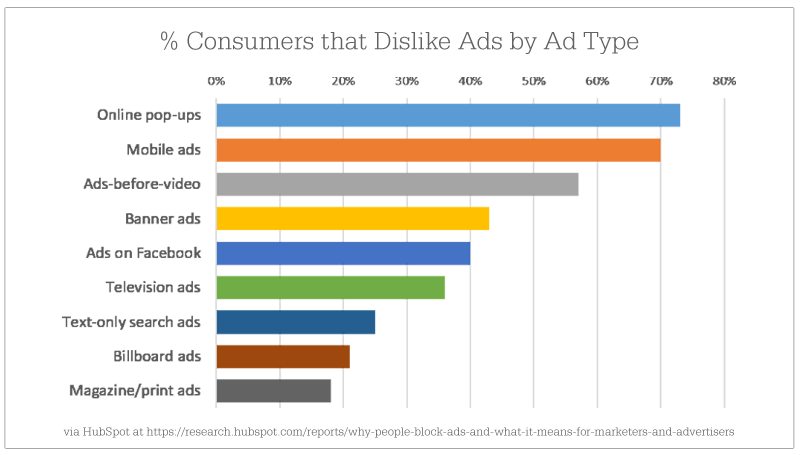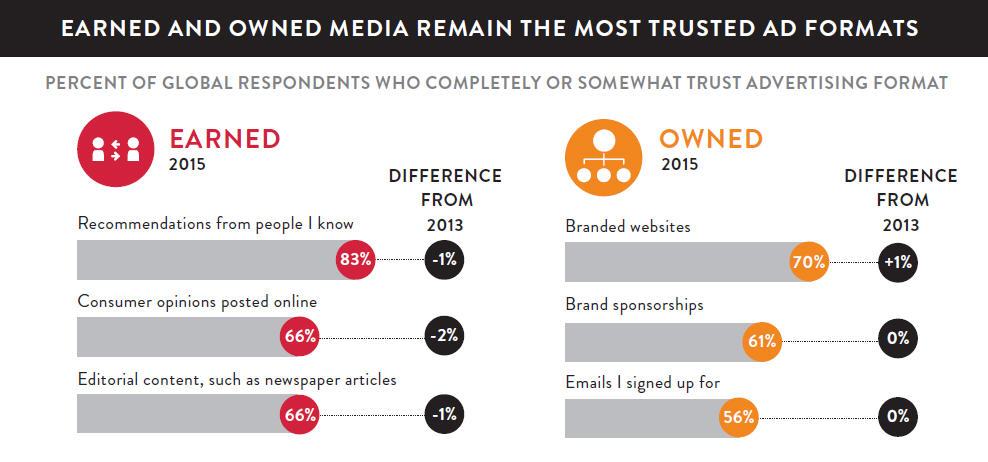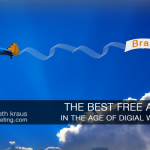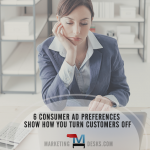10 Things People Hate About Your Digital Marketing Strategy
New data about the type of ads consumers dislike should guide your digital marketing strategy so you can avoid losing traffic and sales due to a poor website visitor experience.
Digital Marketing Strategy Ads Consumers Don’t Hate
Contrary to what you might believe, consumers don’t hate all ads. In Nielsen’s 2015 Global Trust in Advertising study, data showed that consumers react favorably to many different types of marketing. For instance, 80 percent welcome recommendations from people they know. While that includes personal acquaintances, remember we’ve also talked about the fact that nearly all consumers trust online reviews from strangers just as much as they trust word of mouth reviews from people they know.
Also high up on the list of digital marketing strategy advertising consumers trust are brand websites, editorial content and articles (such as blogs), online reviews, ads in print or on television or billboards, brand sponsorship of events and causes, email marketing and more. However, when we start getting under the 50 percent mark on this list of ad types consumers trust, we start to encounter the same types of ads they dislike most.

In reality, it’s not so much the format of an ad that makes consumers hate it. It’s how that format tends to impact their experience; and sometimes, what they infer about a brand’s intentions that trigger these ten types of negative responses. Let’s take a closer look at the HubSpot survey results.
10 Things People Hate About Your Digital Marketing Strategy
1. It’s Just a Little Too Creepy
More than 90 percent of respondents agreed or strongly agreed that online ads are more intrusive than they were even 2-3 years ago. Many consumers feel like technology makes it too easy to stalk site visitors and big data, registration and contact forms put more information at marketer’s fingertips than they really need.
2. It’s Frustrating, and that’s Annoying
You know those pop-ups that you’re making site visitors deal with any time they want to access even the itty-bittiest bit of content on your website? It’s annoying. When site visitors have to decide whether to allow your site to cookie them, know their location or even turn on push notifications from your brand just to read a blog article, get to your product landing page or do anything at all it’s the equivalent of making new customers run an obstacle course to get into your store.
3. It’s Excessive
Whether there are simply too many ads on your website or consumers are getting weary of having to navigate the ads found on all the sites they’re visiting, it’s enough already.
4. It’s Bad Branding
85 percent of study respondents agreed or strongly agreed that obnoxious or intrusive ads negatively impact their perceptions about the brand being advertised, and even more (86 percent) felt negatively about the brands that allowed the ads.
5. It’s Obnoxious
In their never-ending battle to win the attention of consumers, today’s marketers have to get more and more creative to overcome the consumer’s tendency to ignore ads. In many cases this means ads get more obnoxious and intrusive, because getting more creative and engaging is hard.
6. It’s Invasive
Technology makes retargeting more and more specific to site visitors’ recent behavior. While in some cases it reminds buyers to revisit a site or check out a product they’re now ready to buy, in others this type of “personalization” feels just a little too personal. (If you know what I mean.)
7. It’s Unstoppable
No matter how good ad blockers get, advertising tech is always a step ahead. Many internet users wish they had the power to filter ads in some way.
8. It’s Poorly Done
Seemingly, coming up with clever, engaging and entertaining ad copy is hard, because 63 percent of internet users agree or strongly agree that most of the ads they’re seeing aren’t polished or professional. Nearly as many even agree that the ads they’re seeing online are actually insulting to their intelligence. Nothing “sells” like condescension!
9. It’s a Necessary Evil
Many internet users navigate through, around, under and alongside ads with a sense of duty, feeling it’s the price they pay to access the “free” content available to them. Whether or not they’ll return to your site or click through to more ad-heavy content, then, is largely dependent on just how valuable that content is to them.
10. Ads? What Ads?
Your digital marketing strategy might not be hated, it might be MIA! The average internet user’s brain is pretty darn good at completely ignoring most of today’s digital ads and marketing content. They might not hate your brand’s digital marketing strategy, but that doesn’t mean it’s effective.
Is it time for you to develop the digital marketing strategy your brand deserves? We can help. From site design and development to content that your audience will value, we’re ready to help you improve engagement and get real results from your digital marketing plan.
Just ask! Contact Us Online






